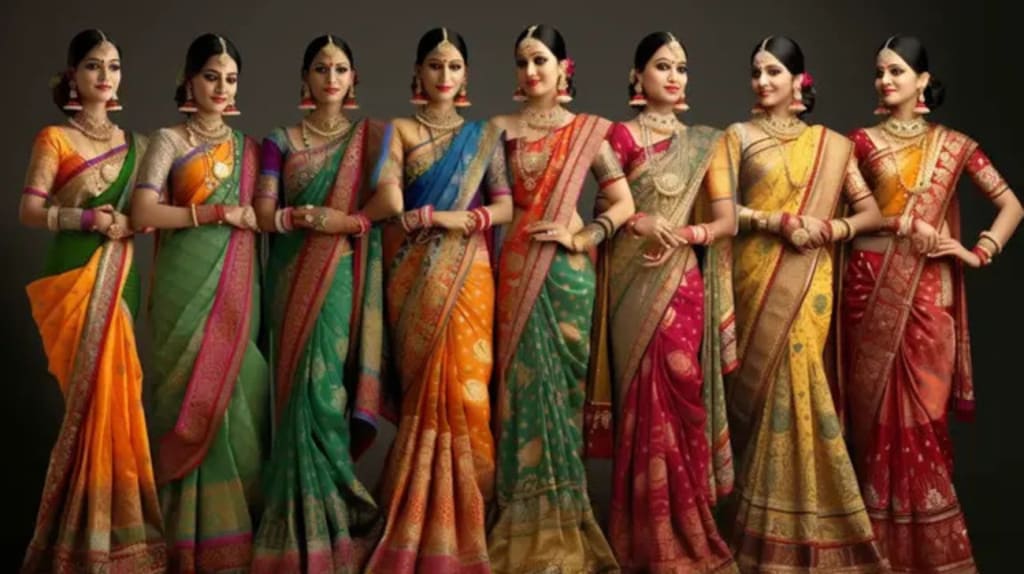
Around the world, sarees are deeply ingrained in many cultures. In South Asia, this includes Bangladesh, India, Nepal, Sri Lanka, and Pakistan. Beyond just being a piece of clothing, the item has a deep cultural meaning and long history. An outline of the saree culture is shown below:
Historical Significance: There is evidence that sarees have been worn for centuries, going all the way back to the Indus Valley Civilization (c. 2800–1800 BCE). Sarees have changed over time in terms of design, material, and draping methods to reflect shifts in society standards, fashion, and culture.
Regional Diversity: Different regions have distinct saree styles, each with its own embroidery, motifs, and weaving processes. A few instances of the wide variety of sarees found in South Asia are the Kanjeevaram saree from Tamil Nadu, the Banarasi saree from Uttar Pradesh, the Jamdani saree from Bangladesh, and the Baluchari saree from West Bengal.
Occasions & Rituals: Sarees are worn for a variety of occasions, ranging from regular wear to important gatherings like religious rituals, weddings, and festivals. More ornate and opulent sarees are saved for weddings and joyous occasions, as the style of saree chosen frequently represents the importance of the event.
Tradition and Symbolism: Sarees represent grace, elegance, and tradition. As heirlooms, they are frequently handed down through the generations, bringing memories and tales from bygone eras. Sarees also represent cultural notions of modesty and beauty, and are linked to femininity and women.
Fashion & Trends: Sarees are still deeply rooted in tradition, but they also change to reflect shifting tastes and fashion trends. Saree designs are a popular subject for modern designers to play with, incorporating modern touches while honoring the workmanship and methods of the past.
Economic Importance: Millions of artisans, weavers, dyers, and embroiderers are employed by the saree industry, which contributes significantly to the economies of many South Asian nations. In particular, handloom sarees are prized for their artistry and help to maintain traditional weaving methods.
Global Influence: Sarees have become more well-known and appreciated globally as a result of Indian fashion and culture's rising appeal on a global scale. People of many nations and ethnicities wear them to celebrate and accept diversity in addition to making a fashion statement.
Sarees, which symbolize the rich tapestry of South Asian heritage, are fundamentally more than simply clothing; they are representations of culture, tradition, workmanship, and identity.
Sarees come in a wide variety of styles, each having a unique weave, fabric, and cultural importance. Here are a few of the most well-liked saree styles from various parts of India:
Tamil Nadu is the birthplace of the Kanjeevaram saree, which is renowned for its elaborate zari embroidery, vivid colors, and luxurious silk fabric. Temples and the natural world serve as inspiration for their vivid patterns and motifs.
Banarasi Saree: Originating in Varanasi, Uttar Pradesh (formerly known as Banaras), Banarasi sarees are made of quality silk and adorned with rich motifs including floral designs, peacocks, and paisleys, as well as zari borders and delicate brocade work.
Chanderi Saree: The Madhya Pradesh town of Chanderi is the origin of Chanderi sarees. They are distinguished by their translucent fabric, airy feel, and classic designs woven with silk or zari threads. Chanderi sarees frequently include geometric patterns and delicate motifs derived from nature.
Bandhani Saree: Hailing from Rajasthan and Gujarat, these sarees are distinguished by their intricate patterns of dots, squares, and waves created by securely tying small parts of the fabric with threads before dying.
The Paithani saree is a traditional Maharashtrian saree that is renowned for its vivid colors, silky silk fabric, and delicate handmade peacock designs. They frequently have elaborate borders adorned with silver or gold zari work, as well as a gorgeous pallu (endpiece).
Sambalpuri Saree: Made in Odisha, Sambalpuri sarees are a product of the ikat, or tie-and-dye, technique. They are renowned for their vivid colors and elaborate designs, and they include traditional motifs like phula (flower), chakra (wheel), and shankha (conch shell).
Tant Saree: Handwoven in Bangladesh and West Bengal, tant sarees are classic cotton Bengali garments. They are renowned for their crisp texture, simple yet exquisite designs, and lightweight, breathable nature. These designs frequently incorporate geometric patterns, paisleys, and floral motifs.
Jamdani Saree: Jamdani sarees are handwoven garments that are typically distinguished by geometric shapes, floral patterns, and paisleys. They are originally from Bangladesh. Their discontinuous weft weaving method produces a sheer, light-weight cloth.
Gujarat is the home of the Patola saree, which are renowned for their double ikat weaving technique, in which the warp and weft threads are dyed before weaving to produce elaborate geometric shapes and patterns. Patola sarees are exceedingly valued due to their exquisite workmanship and vivid hues.
These are but a few illustrations of the wide variety of sarees that can be found all over India; each one reflects the distinctive cultural heritage and handiwork of its particular area.






Comments
There are no comments for this story
Be the first to respond and start the conversation.